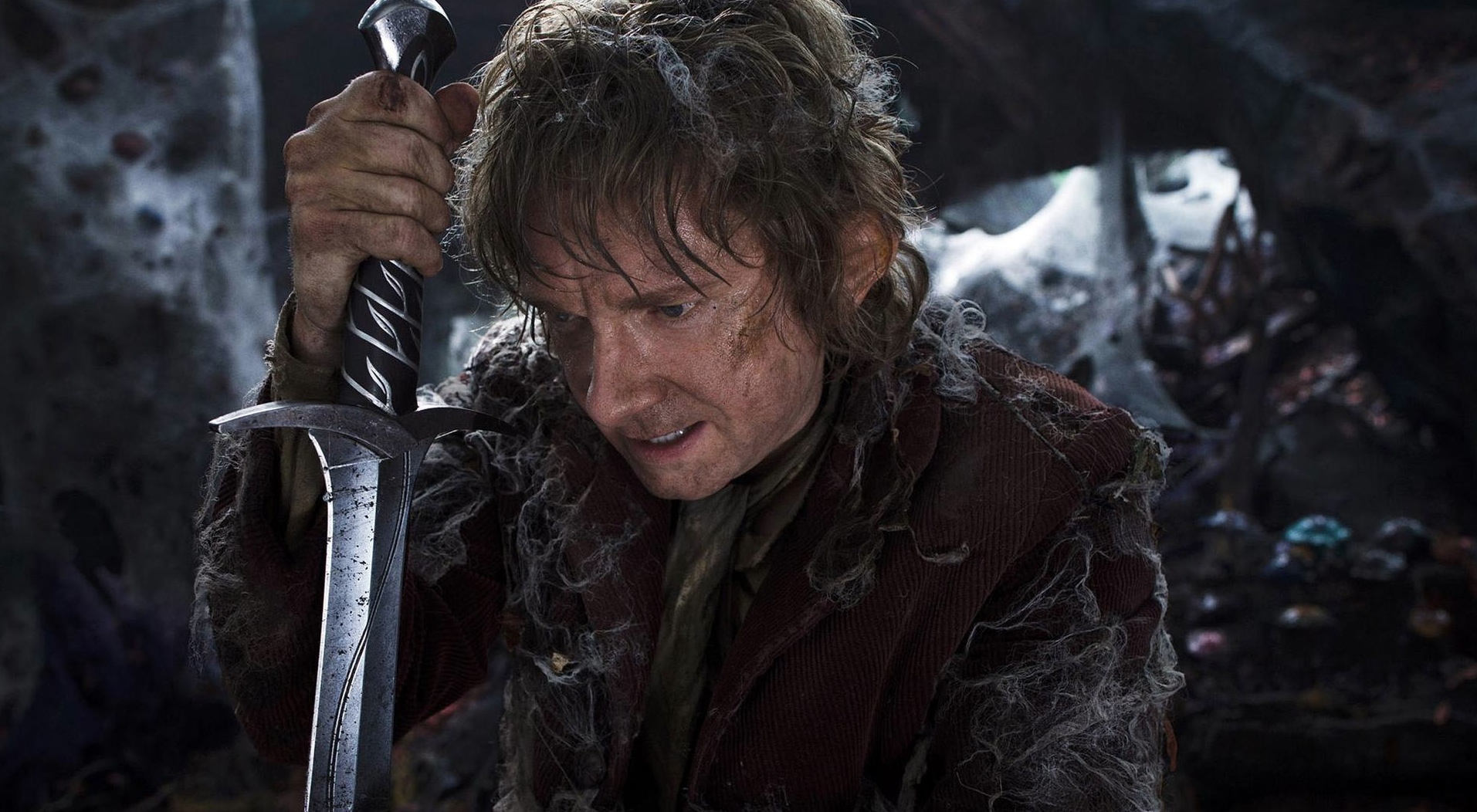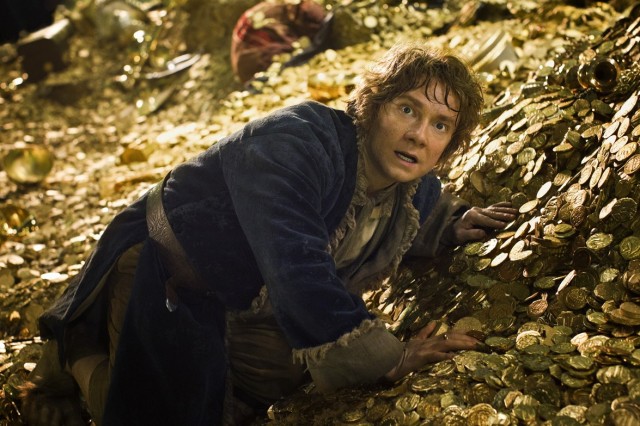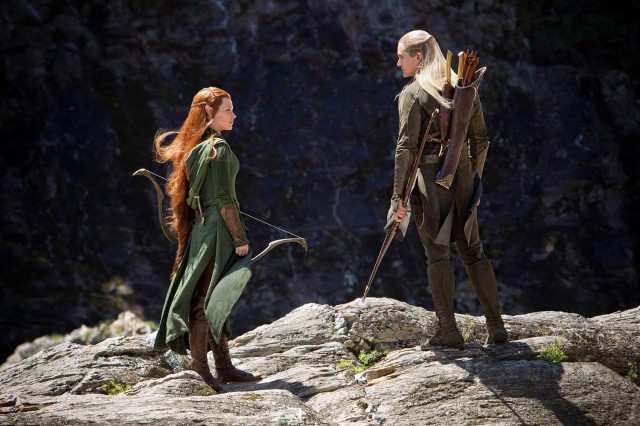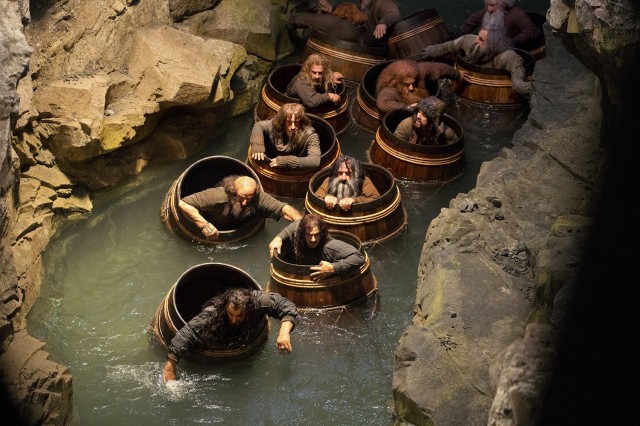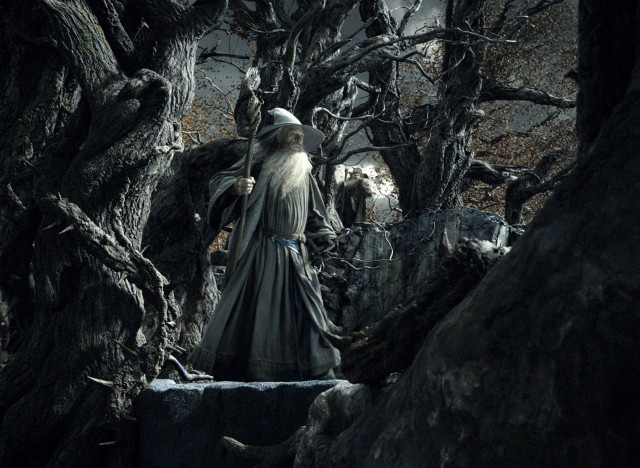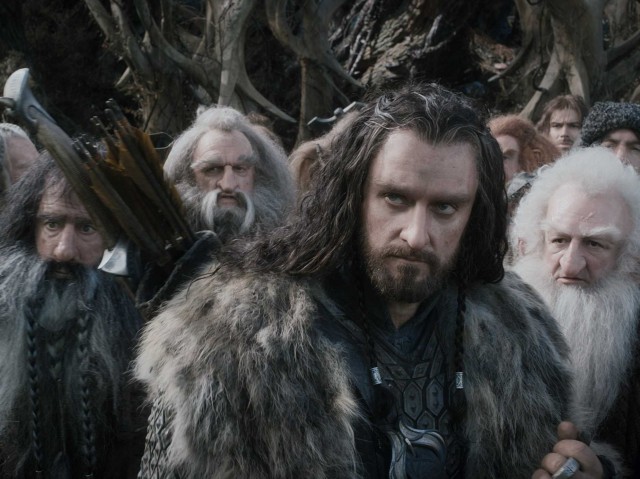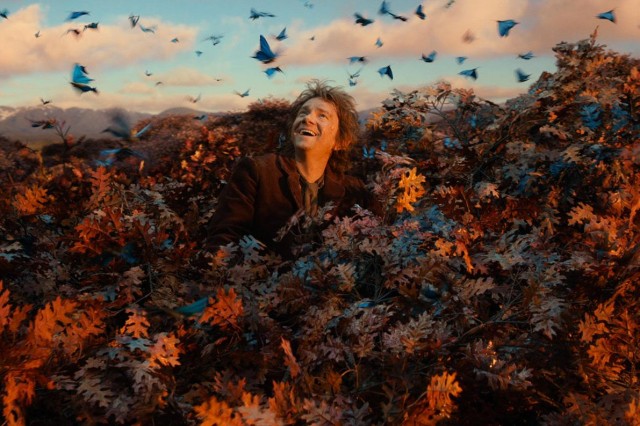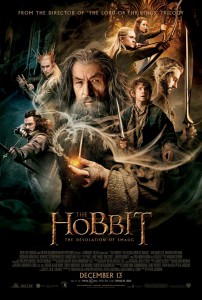 Beloved J.R.R. Tolkien children’s book, The Hobbit being split into three movies to serve as a lengthy prequel to the Lord of the Rings movie trilogy has continued to be met with controversy. Despite the single novel originally being planned as two movies, a third bridging movie ended up being placed in the middle, that being The Hobbit: The Desolation of Smaug, which is meant to precede the originally planned prequel finale, The Hobbit: There and Back Again, now hitting theatres in December of next year.
Beloved J.R.R. Tolkien children’s book, The Hobbit being split into three movies to serve as a lengthy prequel to the Lord of the Rings movie trilogy has continued to be met with controversy. Despite the single novel originally being planned as two movies, a third bridging movie ended up being placed in the middle, that being The Hobbit: The Desolation of Smaug, which is meant to precede the originally planned prequel finale, The Hobbit: There and Back Again, now hitting theatres in December of next year.
As the title suggests, the main draw of the second movie is the fact that audiences will finally get to properly see one of the most iconic elements of The Hobbit as a source novel, that being fearsome dragon, Smaug. Even then however, the follow-up to last year’s original The Hobbit: An Unexpected Journey is in general a more exciting and entertaining movie than its rather bloated, sluggish predecessor.
The Desolation of Smaug still doesn’t quite achieve the outstanding quality of the three Lord of the Rings movies from the early 2000’s, but it’s undeniably a superior sequel to An Unexpected Journey in pretty much every fashion. Like Thor: The Dark World and The Hunger Games: Catching Fire, it’s another strong blockbuster that demands to be seen in these final weeks of 2013!
The majority of leads from An Unexpected Journey return in The Desolation of Smaug, including the band of dwarves, Lord of the Rings wizard, Gandalf the Grey, and of course, the first movie’s protagonist, Bilbo Baggins. Yes, I emphasize that this was mainly true in the first movie, since The Desolation of Smaug seems to push Bilbo into the background much more often.
Oh yes, Bilbo is still a key character in the plot, but he no longer feels like the central character. The main protagonist of the second movie feels more like dwarven leader, Thorin Oakenshield, if anyone, particularly when Bilbo’s character arc is entirely excised in the second movie, ultimately making Bilbo feel like a plot device and little else. Every conflict, every bit of foreshadowing and every bit of exposition entirely revolves around the dwarves and their quest now. Bilbo is just firmly along for the ride this time.
Likewise, Gandalf, who also disappeared in the source novel around these events, gets far less screentime in the second movie. He merely exists to continue tying this prequel trilogy into the inevitable events of the Lord of the Rings movies, and the conclusion of his arc before There and Back Again feels a bit unsatisfying. On this note, Gandalf’s wizard companion, Radagast the Brown, a big highlight personality in An Unexpected Journey, has little more than a cameo in one scene during The Desolation of Smaug.
Fortunately, new characters like human lake-man, Bard, played by Luke Evans, and female wood-elf captain, Tauriel, played by Evangeline Lilly, spruce up proceedings in lieu of the wizards. While Bard was another important character in the source novel, Tauriel is a completely new character made up for the movie, though still undeniably fitting in the spirit of Tolkien. Tauriel’s presence also serves as an excuse to re-integrate Lord of the Rings wood-elf warrior, Legolas (once again played by Orlando Bloom) into the story of The Desolation of Smaug, despite Legolas never appearing in Tolkien’s original prequel novel.
While Bilbo often feels like a secondary personality in his own movie for now, the better mix of character arcs makes for a more entertaining movie overall, one that better justifies its massive sense of scale. The second movie effectively teases the climactic events of There and Back Again between its many personalities, culminating in a truly terrifying introduction to the mighty dragon, Smaug, voiced exceptionally by Benedict Cumberbatch!
Making The Desolation of Smaug an ensemble movie more akin to the Lord of the Rings trilogy was definitely the right call, since the personalized direction of centering solely on Bilbo for the first movie just made it feel plodding and slow in many places. The Desolation of Smaug on the other hand actually feels like it deserves to be nearly three hours long, since you won’t be tired of its superb and varied personalities even then, despite the decreased personal stakes for its supposed lead character.
An Unexpected Journey covered the events of The Hobbit leading up to Thorin’s company escaping the orcs (goblins in the source novel) and wargs chasing them out of the goblin tunnels. The Desolation of Smaug obviously covers the span of the novel that sees them successfully reach the lost dwarf kingdom to confront the titular dragon.
Of course, with The Desolation of Smaug being an ensemble movie, viewers will now get to see how the quest of the dwarves affect other factions of Middle-earth. We see the proper stakes and motivations behind those who would challenge the dragon or let him lie. We also naturally see so many continued teases that Smaug will soon be the least of Middle-earth’s worries, as the forces of the dark lord, Sauron continue to stir in the background, setting the stage for the events of The Lord of the Rings.
The presence of Bard and his lake village show the state of men in Middle-earth before the threat of Sauron and the One Ring, just as the presence of Legolas, Tauriel and the wood-elves show how elven kingdoms beyond the majesty of Rivendell are perceiving the dwarves’ seemingly foolish quest to retake their homeland from Smaug. Again, much better than An Unexpected Journey, The Desolation of Smaug recreates the truly large, dynamic world of Middle-earth done so well in The Lord of the Rings, a world that remains in motion, even beyond the eyes of the titular hobbit character.
The first movie was full of stretches and stops, ultimately being more awkwardly paced, but the better-realized scale of The Desolation of Smaug leads to a story that is more engrossing and entertaining overall, not really feeling like a nearly three-hour movie in the end. This is one of the central reasons why the second movie is far superior to the first, and should be better enjoyed even by audiences who were rather disappointed by An Unexpected Journey.
For those curious about how There and Back Again fits into proceedings, one potentially disappointing element to the story is that Smaug is ultimately not defeated in the second movie, leaving The Desolation of Smaug to simply end in a cliffhanger with the dragon about to attack Bard’s town. It’s the same annoying ‘stop’ moreso than a proper ‘end’ that The Hunger Games: Catching Fire suffers from as well, simply demanding that audiences come back next year for the next part of the story. This marks the only part of the plot in this second movie that feels unsatisfying.
Also slightly unsatisfying is the fact that Gandalf has to be sidelined to keep with events in the novel for this part of the story. The movie uses this as a good excuse to explore Sauron’s imminent return to power, though it leads to Gandalf being abruptly dropped shortly before the third act, simply being captured by Sauron and never seen again for the rest of the movie. Yes, this implied scenario was mentioned in the book, but it’s disappointing nonetheless that Ian McKellen is given so little to do for this second movie beyond cower before Sauron and his dark forces.
Fortunately, the second movie offers a climactic confrontation with Smaug within his treasure-filled lair that does not take place in the source novel. It incorporates almost all of the dwarves on top of Bilbo, and is a truly amazing and spectacular scene that sees the dwarves attack and outwit Smaug using the forging machinery of the abandoned dwarf kingdom. Even with all of the large-scale battles in the Lord of the Rings movies, this could very well be one of the most ambitious, creative and exciting scenes in Peter Jackson’s entire Middle-earth saga, easily comparing to Gandalf’s famous fight with the Balrog of Morgoth from The Lord of the Rings!
Peter Jackson has decided to better borrow from his Lord of the Rings formula’s multi-layered, ensemble style for The Desolation of Smaug, and it makes the second movie much more exciting and entertaining than its sometimes-slow predecessor overall. The movie is still very lengthy at 161 minutes, but at least it almost never spends time wasting scenes on songs, walking and other plodding sequences that non-fans often mock the Lord of the Rings movies for, which were worse than ever in An Unexpected Journey.
The Desolation of Smaug is put together exactly how a middle installment in a trilogy should be however. It raises the stakes of the first movie, while also laying the groundwork for even greater things to come in the third. Yes, the key character conflict of Bilbo has now been pretty well entirely removed from the second movie, but it’s an acceptable sacrifice for the sake of better pacing and entertainment this time.
Also improved are the action scenes, which, again, take more inspiration from the more violent combat in The Lord of the Rings. The Desolation of Smaug is still presented in a more colourful, fantastical style than the dark, grungy Lord of the Rings movies, but the second movie has now given up any delusion that it still somehow has to be a kids’ story on some level, which just led to a strange style clash in An Unexpected Journey.
Peter Jackson finally finds the best of both worlds in his direction here, using the more colourful style to create more creative and memorable action than not just An Unexpected Journey, but also in a way that’s different from the extremely impressively-realized, but mostly standard war scenes throughout the Lord of the Rings movies. There’s still some slight mischief and humour in several highlight skirmishes throughout the movie, particularly involving the secondary dwarves, but the fact that The Desolation of Smaug has largely removed the kid gloves with its fighting makes it better tie into the Lord of the Rings movies that came before, leading to a better sense of consistency and overall quality in direction.
Howard Shore once again returns as composer for The Desolation of Smaug, though makes the effort to try some new music tracks for the second movie. The main dwarven theme song from An Unexpected Journey is now absent from the soundtrack, as are any moments where the dwarves sing, which may be good news to some who longed for better pacing in the first movie.
The new orchestral tracks that play throughout the movie are still quite exceptional, particularly the bombastic theme of Smaug that plays for the climax. You’ll hear a few understated variations of tracks from the Lord of the Rings movies, specifically the themes of the One Ring, Sauron and occasionally The Shire, perfectly foreshadowing events to come while also tickling any established love you may have for Peter Jackson’s prior movie trilogy.
Peter Jackson’s Lord of the Rings movies carry with them some of the best soundtracks in modern filmmaking, and The Desolation of Smaug continues to do that tradition proud, carving out its own identity, but still being true to the majestic and memorable tracks that came before.
Once again, The Desolation of Smaug stands tall as a hallmark of superb special effects and production values! Yet more sets from the novel are realized brilliantly here, including the wood-elves’ kingdom, the Lonely Mountain, and most notably a highlight sequence in the ominous and enchanted forest of Mirkwood.
Creature effects continue to be outstanding as well, whether they be monstrous orcs, creepy spiders, and of course, Smaug himself. As expected, Smaug is among the best special effects ever realized in any of Peter Jackson’s Tolkien adaptations, being massive, heavily detailed and very, very imposing! Fans of the source novel will be remarkably pleased with the dragon’s look, as well as his sprawling lair of dwarven treasure!
Like the first movie, I went all out and saw The Desolation of Smaug in IMAX 3D (not at 48 fps), despite An Unexpected Journey having a largely terrible 3D job and disappointing IMAX cut. Fortunately, the second movie considerably improves the quality of the 3D and IMAX elements, even if it’s still a little middling on both counts for the most part. Despite that, the movie is much better shot to accommodate 3D this time, having atmospheric effects and flying props circle the audience, as large environments like Smaug’s treasure room and Mirkwood benefit greatly from the expanded, stretching atmosphere of the IMAX 3D cut in particular.
If you’d rather keep watching the movie flat without 3D, IMAX and/or 48 fps, that’s still quite manageable. There are a few obvious ‘3D moments’ that will become very noticeable in the 2D cut, but thankfully, they’re rare.
For those who do like to go all out with 3D, IMAX and/or 48 fps for big blockbusters like this however, it’s great to see that a major criticism of the first movie has been addressed, now making the 3D and IMAX 3D cuts actually worth shelling out for this time. Yes, you still won’t be floored by the 3D elements nor the IMAX elements, but they do work in the movie’s favour and do undeniably improve the experience this time, making them worth the added price now, unlike An Unexpected Journey.
Even just watched in 2D however, the incredible realization of Middle-earth, its creatures and its magic remains an incredible treat for the eyes, especially with the more bright and colourful style that is carried over well from the first movie!
The Desolation of Smaug makes improvements to Peter Jackson’s The Hobbit trilogy across the board, being a vastly more entertaining and satisfying follow-up to its predecessor that demands to be seen by fantasy blockbuster fans, particularly fans of the Middle-earth saga! It builds a lot of healthy momentum for next December’s finale in There and Back Again, while also standing on its own merits as one of the best must-see Fall/Winter movies of 2013!
It’s easy to sneer at the decision to expand one book into two movies, and then in turn into three movies, but seeing that The Desolation of Smaug is in many respects what An Unexpected Journey should have been, it’s likely that you’ll no longer care after seeing it. If this same high quality and excitement can be maintained for There and Back Again, then we’ll have our much-deserved justification for another nine-hour trilogy to go with The Lord of the Rings.
Besides, you finally get to see the dragon! Isn’t that what most of us paid for in the first place?

